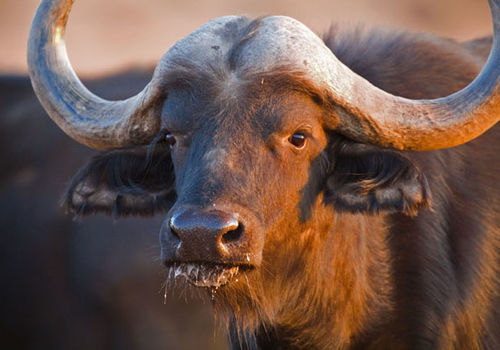
Buffalo
Syncerus cafferBuffalo
Introduction: The buffalo (Syncerus caffer) is a very large, heavily built animal with an ox-like appearance. They are a relative of the domestic cow, and they have strong, heavy legs to support their build and the front hooves are distinctly larger than the hind, an indication of the extra weight they carry in the huge head and thick neck. They are a gregarious creature and herds can number in their thousands, subject to seasonal movements.
Within a herd there is a 'linear' hierarchy among the adult bulls which is maintained by threat behaviour. Herds are quick to stampede if disturbed. The horns are massive, arising from broad, heavy bosses that meet in the centre. They swing outwards and downwards, narrowing from the lowest point, from which they curve upwards and inwards and slightly backwards towards the tip. Lions are the main predator.
Distribution: Buffalo can only be found in the Zambezi Region (formerly the Caprivi Strip) and Waterberg Plateau Park area of Namibia, as well as on the banks of the Chobe and Zambezi Rivers.
Diet: Buffalo are predominantly grazers, but a small percentage of browse as well. They are selective feeders, with a preference for grasses. As their huge body weight requires maintaining, they seek areas with a plentiful supply of food and will wander a very wide area away from water.
Colouring: Old males are black, but females rarely attain the same degree of black and usually show a tinge of reddish-brown.
Breeding: Gestation period is between 330 to 346 days. The calves require several hours before they are strong enough to join the herd. They are susceptible from attack from spotted hyena, but the herd is notorious for offering good security and protection.
Size: Buffalo of both sexes stand about 140cm at the shoulder and adult males weigh up to 800kg and the female slightly smaller at around 750kg.
Klein Windhoek

